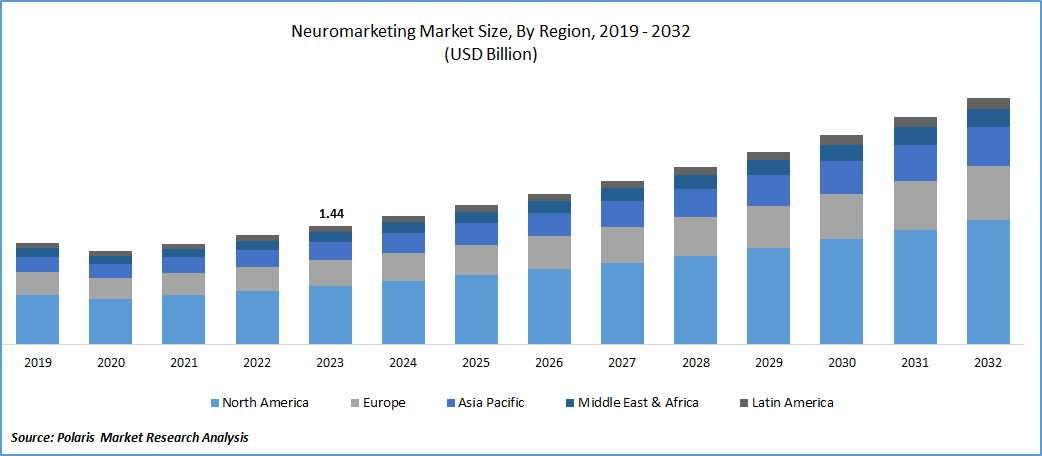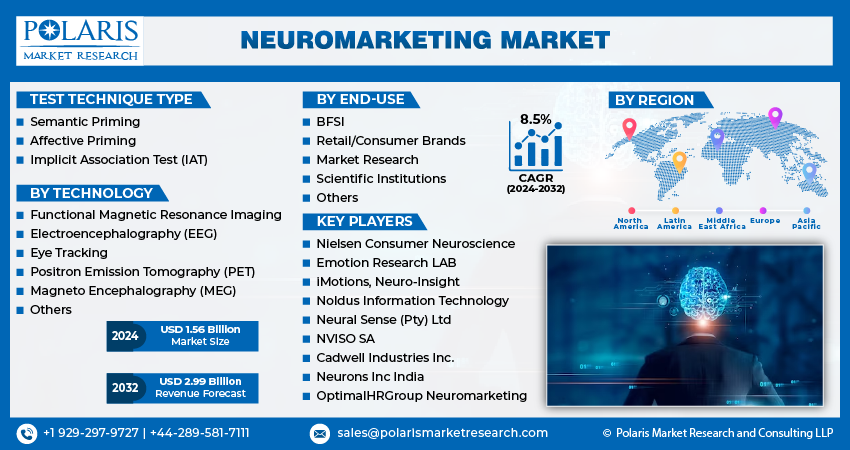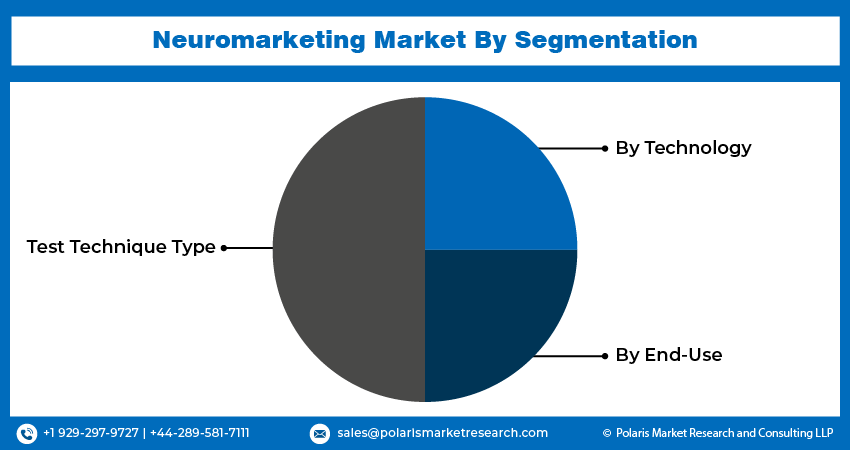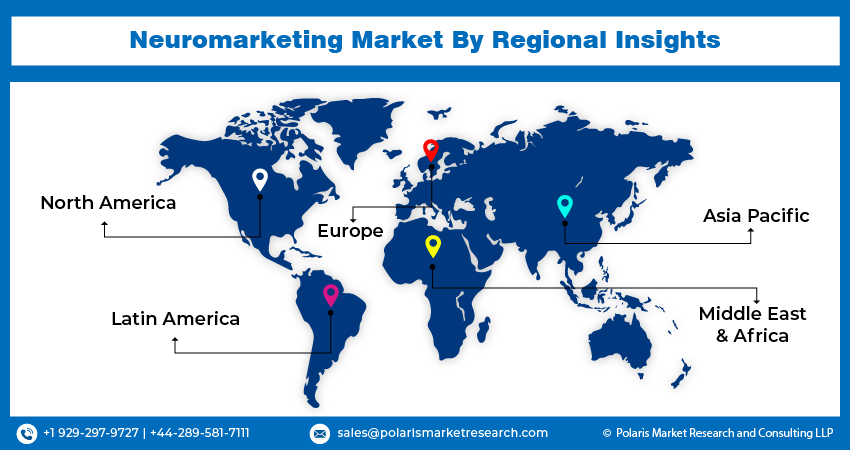
Neuromarketing Market Share, Size, Trends, Industry Analysis Report, By Test Technique Type (Semantic Priming, Affective Priming, and Implicit Association Test (IAT)); By Technology; By End-Use; By Region; Segment Forecast, 2024 - 2032
- Published Date:Mar-2024
- Pages: 119
- Format: PDF
- Report ID: PM4482
- Base Year: 2023
- Historical Data: 2019-2022
Report Outlook
The global Neuromarketing market was valued at USD 1.44 billion in 2023 and is expected to grow at a CAGR of 8.5% during the forecast period.
Increasing demand for innovative and customer-centric marketing strategies that can enhance customer loyalty, retention, and satisfaction are the key factors influencing market growth. Neuromarketing offers insights into the subconscious and emotional aspects of decision-making, which are often overlooked by traditional marketing methods. By using techniques such as facial recognition, eye-tracking, biometrics, and implicit association tests, neuromarketing can help brands and agencies to design more effective and personalized marketing campaigns, products, and services.
Neuromarketing can help marketers evaluate the effectiveness of their marketing stimuli, such as ads, products, and content by measuring the brain and bodily responses of consumers. Neuromarketing can also help marketers apply the insights from neuroscience and cognitive science research to design more persuasive and engaging marketing campaigns. Neuromarketing services are in high demand, as companies across the globe are seeking for personalized experience and boost consumer engagement.

To Understand More About this Research:Request a Free Sample Report
One of the key areas where neuromarketing is making and critical impact is the mobile space, where smartphones have become an integral part of lives. The rise of e-commerce and digital marketing has created a significant demand for new marketing technologies such as neuromarketing which can effectively analyze consumer behavior and preferences. In today’s business landscape, companies across the globe increasingly seeking ways to gain competitive edge in market. Neuromarketing offers unique opportunity for businesses to differentiate their marketing strategies by finding insights derived from the consumer’s mind.

Growth Drivers
- Rising Adoption of Novel Marketing Activities and Increased Investment In Neuromarketing Driving The Market Growth.
Many leading companies and brands, such as PepsiCo, eBay, and Fritolay have implemented neuromarketing research techniques to conduct market research, run focus groups, and design marketing campaigns. Companies are using various technologies, such as functional magnetic resonance imaging (FMRI), electroencephalography (EEG), eye tracking, facial coding, and augmented reality, to measure the brain activity, eye movements, facial expressions, and emotional responses of consumers. These innovative technologies helping companies to identify the key factors that influence consumer behavior, such as attention, memory, emotion, motivation, and trust, and create more engaging persuasive marketing stimuli.
- For instance, to design cars better, Hyundai Motors uses EEG-tests before production. By using this method, the company assess how customers felt about different aspects of the cars- such as the inside and outside look. They aimed to understand customer preferences before making many cars.
- Also, Yahoo, a huge firm, created a 60 second TV ad with cheerful, dancing people. However, it used EEG tests on customers to evaluate the ad before broadcasting it on prime and cable TV. This was done to attract more users to its search engine.
Report Segmentation
The market is primarily segmented based on Test Technique Type, Technology, End-Use, and Region.
|
Test Technique Type |
By Technology |
By End-Use |
By Region |
|
|
|
|
To Understand the Scope of this Report:Speak to Analyst
By Test Technique Type Analysis
- The Implicit Association Test (IAT) Held Significant Market Share in 2023
The Implicit Association Test Segment dominated the global market. The development of new neuromarketing technologies such as EEG and fMRI, has made it easier to conduct IAT tests and analyze the results. This has led to an increase in the adoption of IAT by businesses across the various industries. Also, as competition in the market increases, businesses are looking for a way to gain competitive edge in the market. IAT provides valuable insights into consumer behavior, which can help businesses develop more effective marketing strategies and campaigns.
By Technology Analysis
- Functional Magnetic Resonance Imaging (FMRI) segment accounted for the largest market share in 2023
The FMRI technology segment dominated the market. This dominance is due to its ability to provide detailed images of brain activity, which allows better understanding of consumer responses and marketing stimuli. The characteristics of this technology such as high precision and non-invasiveness make it preferred choice for researchers and marketers. The increasing awareness about the potential benefits offered by neuromarketing techniques and the growing advertising spending of businesses are also poised to act as a major growth factor for this segment.
By End-Use Analysis
- Retail/Consumer Brands segment held the significant market revenue share in 2023
The growing demand for neuro-analytics in the retail and consumer brand sector is contributed to the adoption of neuromarketing technologies. Major retail and consumer brands such as PepsiCo, The Weather Channel, eBay, Daimler, Campbell's, Frito-Lay, Gerber, and others have implemented neuromarketing research techniques to understand consumer behavior, conduct market research, and enhance their marketing strategies. These technologies provide valuable insights into consumer behaviors, helping businesses to make data-driven decisions and improve their marketing strategy. Neuromarketing helps retail and consumer brands to optimize their products and services, leading to improved customer experience. By using this technology businesses can make informed decisions about their marketing strategies, store layouts, and product offering to enhance consumer satisfaction.

Regional Insights
- North America region dominated the global market in 2023
The North America region dominated the global market. Region is a hub for technological advancements with strong presence of key players and research institutions at the forefront of developing and advancing neuromarketing technologies. It is also a hub of major market research companies such as Nielsen, Westat, Forrester Research Services, and Momentive which are integrating neuromarketing technologies into their practices. Also, the region’s emphasis on consumer-centric marketing strategies has propelled the growth of the neuromarketing market. Businesses in the region is increasingly focusing on understanding and catering to evolving needs and preferences of consumers, which also driving the regional growth of the market.
The Europe region is expected to grow at fastest CAGR during the forecast period. The increasing awareness and acceptance of neuromarketing solutions in Europe expected to create significant growth opportunities in the market during the forecast period. European companies are increasingly focusing on consumer-centric strategies to gain a competitive edge. For example, the Swedish furniture retailer IKEA used neuromarketing techniques to understand how consumers navigate its stores and make purchasing decisions.

Key Market Players & Competitive Insights
The global neuromarketing market is characterized by intense competition and diverse landscape of key players offering a wide range of services and solutions. As the demand for neuromarketing research and insights continuous to grow, companies are investing more and more in research & development activities. Key players are continuously investing in the development of advanced neuroimaging technologies, to enhance the accuracy and efficiency of neuromarketing research.
Some of the major players operating in the global market include:
- Nielsen Consumer Neuroscience
- Emotion Research LAB
- iMotions
- Neuro-Insight
- Noldus Information Technology
- Neural Sense (Pty) Ltd
- NVISO SA
- Cadwell Industries Inc.
- Neurons Inc India
- OptimalHRGroup Neuromarketing
Recent Developments
- In May 2023, Nielsen and digitalAudience partnered to enhance open web measurement in the Northern western Europe. This collaboration involves integrating demographic data provided by the digitalAudience into its Nielsen Identity System.
- In September 2022, Tobii and HeadVantage partnered to bring eye tracking to sports fans and athletes. This collaboration will allow sport fans to gain insight into athlete’s decision-making processes and aid them in their training and improvement across various disciplines.
- In December 2021, Smart Eye introduced Smart Eye Pro 9.3 solution, featuring 120 Hz eye tracking non-intrusive Dx camera. This innovative product offers improved eyelid detection in the high resolution with help of Dx camera.
Neuromarketing Market Report Scope
|
Report Attributes |
Details |
|
Market size value in 2024 |
USD 1.56 billion |
|
Revenue forecast in 2032 |
USD 2.99 billion |
|
CAGR |
8.5% from 2024 – 2032 |
|
Base year |
2023 |
|
Historical data |
2019 – 2022 |
|
Forecast period |
2024 – 2032 |
|
Quantitative units |
Revenue in USD billion and CAGR from 2024 to 2032 |
|
Segments covered |
By Test Technique Type, By Technology, By End-Use, By Region |
|
Regional scope |
North America, Europe, Asia Pacific, Latin America; Middle East & Africa |
|
Customization |
Report customization as per your requirements with respect to countries, region, and segmentation. |
FAQ's
Neuromarketing Market report covering key segments are Test Technique Type, Technology, End-Use, and Region.
Neuromarketing Market Size Worth $ 2.99 Billion By 2032.
The global Neuromarketing market is expected to grow at a CAGR of 8.5% during the forecast period.
North America is leading the global market.
The key driving factors in Neuromarketing Market are Rising Adoption of Novel Marketing Activities and Increased Investment In Neuromarketing Driving The Market Growth.
